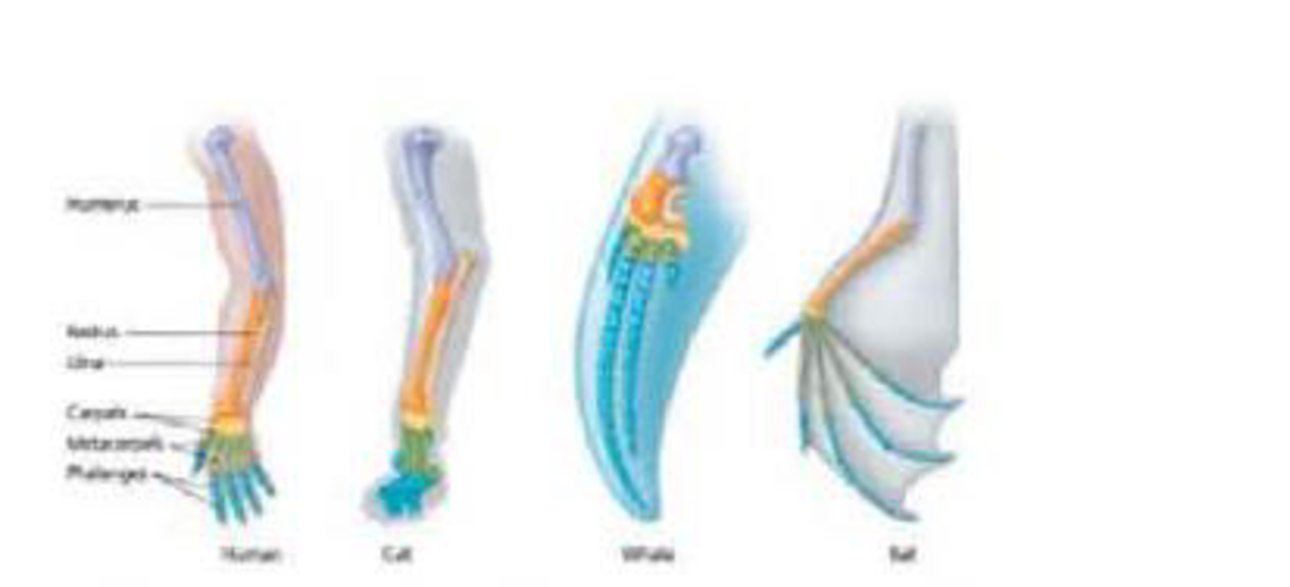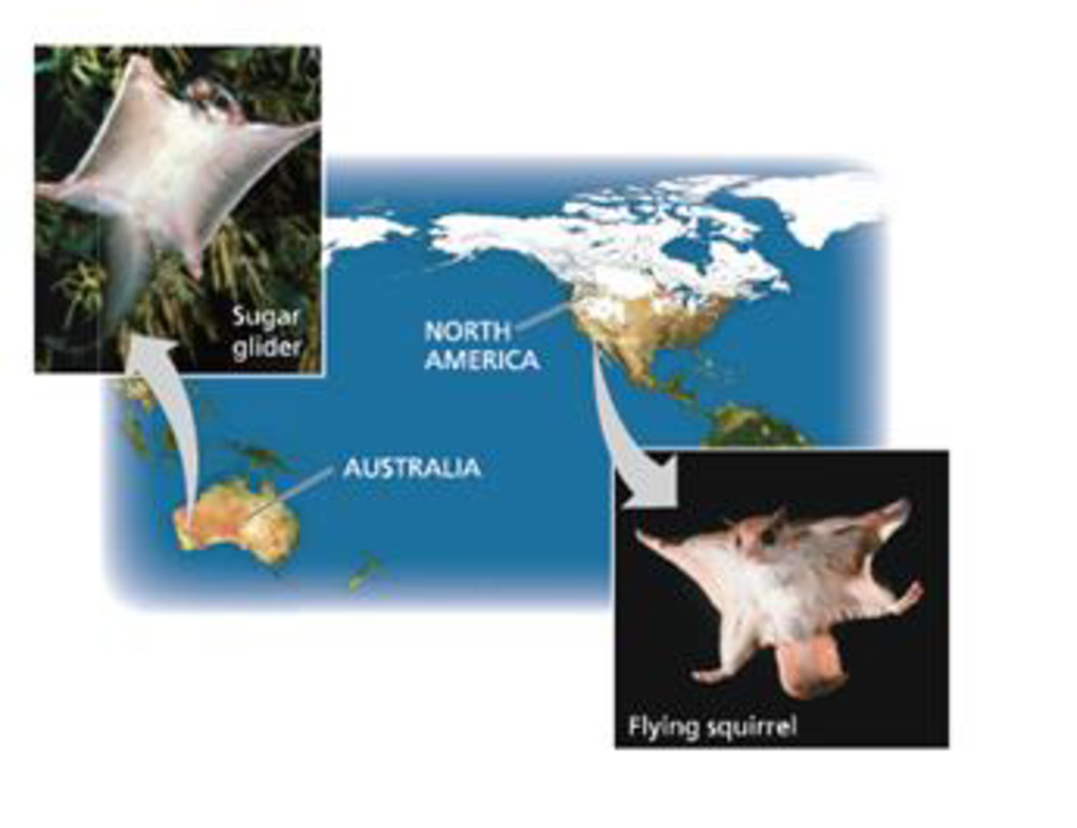
Campbell Biology in Focus
3rd Edition
ISBN: 9780134710679
Author: Lisa A. Urry, Michael L. Cain, Steven A. Wasserman, Peter V. Minorsky, Rebecca Orr
Publisher: PEARSON
expand_more
expand_more
format_list_bulleted
Concept explainers
Textbook Question
Chapter 19.3, Problem 2CC
How does evolution account for (a) the similar mammalian forelimbs with different functions shown in Figure 19.16Q and (b) the similar forms of the two distantly related mammals shown in Figure 19.18Q?

Figure 19.16 Mammalian forelimbs: homologous structures.

Figure 19.18 Convergent evolution.
The ability to glide through the air evolved independently in these two distantly related mammals.
Expert Solution & Answer
Want to see the full answer?
Check out a sample textbook solution
Students have asked these similar questions
Most animals show derived characteristics (character states) that differentiate them from their common ancestor (ancestral character state). However, evolution can also move in reverse, involving the change of a derived character state back to an ancestral state.
Provide two examples from invertebrates of such ‘reverse evolution’ from a derived state (specialized state) back to a more ancestral character state. Make sure to use examples provided in this class. Provide two examples from invertebrates of such ‘reverse evolution’ from a derived state (specialized state) back to a more ancestral character state. Make sure to use examples provided in this class.
Most animals show derived characteristics (character states) that differentiate them from their common ancestor (ancestral character state). However, evolution can also move in reverse, involving the change of a derived character state back to an ancestral state.
Provide two examples from invertebrates of such ‘reverse evolution’ from a derived state (specialized state) back to a more ancestral character state
Mammals belong to a group of amniotes known as synapsids. Three major lineages of mammals had emerged by the early Cretaceous period. In a tabulated form, compare these three lineages to illustrate their diversity in terms of: a. Embryonic developmen, b. How the young are fed and c. Period of gestation
Chapter 19 Solutions
Campbell Biology in Focus
Ch. 19.1 - How did Huttons and Lyells ideas influence Darwins...Ch. 19.1 - MAKE CONNECTIONS Scientific hypotheses must be...Ch. 19.2 - How does the concept of descent with modification...Ch. 19.2 - Prob. 2CCCh. 19.2 - MAKE CONNECTIONS Review the relationship between...Ch. 19.3 - Explain how the following statement is inaccurate:...Ch. 19.3 - How does evolution account for (a) the similar...Ch. 19.3 - WHAT IF? Fossils show that dinosaurs originated...Ch. 19 - Which of the following is not an observation or...Ch. 19 - Which of the following observations helped Darwin...
Ch. 19 - Prob. 3TYUCh. 19 - The upper forelimbs of humans and bats have fairly...Ch. 19 - DNA sequences In many human genes are very similar...Ch. 19 - SCIENTIFIC INQUIRY DRAW IT Mosquitoes resistant to...Ch. 19 - FOCUS ON EVOLUTION Explain why anatomical and...Ch. 19 - FOCUS ON INTERACTIONS Write a short essay (about...Ch. 19 - SYNTHESIZE YOUR KNOWLEDGE This honeypot ant (genus...
Additional Science Textbook Solutions
Find more solutions based on key concepts
What were the major microbiological interests of Martinus Beijerinck and Sergei Winogradsky? It can be said tha...
Brock Biology of Microorganisms (15th Edition)
True or false? Some trails are considered vestigial because they existed long ago.
Biological Science
Nursing Student with Neuropathic Pain
Tamara Costa broke her right tibia and has undergone two separate surger...
Human Anatomy & Physiology (11th Edition)
Propose a model for the assembly of a flagellum in a typical Gram-positive cell envelope.
Prescott's Microbiology
2. A gene is a segment of DNA that has the information to produce a functional product. The functional product ...
Genetics: Analysis and Principles
Define histology.
Fundamentals of Anatomy & Physiology (11th Edition)
Knowledge Booster
Learn more about
Need a deep-dive on the concept behind this application? Look no further. Learn more about this topic, biology and related others by exploring similar questions and additional content below.Similar questions
- Based on the picture, What function do the butterfly and bat wing structures share? How do these structures differ? Give atleast two (2) specific differences. Do these animals share any structural similarities inside their wings that would suggest they are closely related?arrow_forwardFlight in birds developed over time as a result of multiple evolutionary steps. The development of feathers, hollow bones, large flight muscles, and efficient gas exchange were all vital for flight. Describe the order in which these adaptations likely evolved and explain your reasoning.arrow_forwardMammals have a particularly good sense of earing thanks to their inner ear which includes three tiny bones. Reptiles, in contrast, have a single inner ear bone. The lower jaw of reptiles is composed of multiple bones while the lower jaw of mammals is a single bone. Fossil and developmental evidence indicate that the inner ear bones of mammals evolved from lower jawbones. This suggests that the inner ear bones of mammals are 1. an analogy 2. an exaptation 3. a living fossil 4. a transitional trait 5. a vestigial structurearrow_forward
- Neanderthals are recognizably human but have distinctive facial features and a stocky build that were evolutionary adaptations to cold, dry environments. They shared Europe for 10,000 years with Homo sapiens. Today they no longer exist. Beyond these facts the fate of Neanderthals has generated much debate. Why did Neanderthals become extinct? State at least four major factors to explain their fate.arrow_forwardafter the mass extinction that occured 65 million years ago, mammals rapidly diversified to occupy habitats that were previously unavailable to them. What concept does this illustrate?arrow_forwardNeanderthals are recognizably human but have distinctive facial features and a stocky build that were evolutionary adaptations to cold, dry environments. They shared Europe for 10,000 years with Homo sapiens. Today they no longer exist. Beyond these facts the fate of Neanderthal has generated much debate. Why did Neanderthals become extinct? State at least two major factors to explain their fate.arrow_forward
- There are two main groups of bats: Smaller “microbats” navigate by using sonar, and larger “megabats” rely on vision. Mammalogists once though that both kinds of bats evolve from insectivorous mammals. But similarities between the visual systems of megabats and primates have led some researchers to think that megabats may have evolve from primates, perhaps lemurs. What results would support the hypothesis that the two groups of bats have a common origin? Separate origins?arrow_forwardThe fossil record shows that the first mammals evolved 220 million years ago. The supercontinent Pangaea began to break apart 200 million years ago. On which continents would you predict that fossils of the first mammals will be found?arrow_forwardBirds are unique because they have modified forelimbs which serve as wings and a body covered in feathers. However, just having wings and feathers does not mean that an organism can fly (look at the ostrich and penguin!). Please discuss at least 3 of these additional characteristics/adaptations that are required in order for birds to fly.arrow_forward
- Essay on (2 pages): Dogfish sharks (Squalus acanthias) represented “primitive” gnathostomes and cats (Felis catus) represented the “derived” state. Was this appropriate? How does the anatomy of a cat reflect humans’ shared ancestry with sharks?arrow_forwardBased on phylogeny and history of evolution, do new anatomical features such as lungs (amphibians) arise de novo or came from pre-existing structures of their ancestors (like gills of fish)? Explain.arrow_forwardNeanderthal fossils were first discovered in the nineteenth century. Study of their morphology suggested that Neanderthals were more closely related to humans than any living species of primate was. Much later, it became possible to sequence DNA from Neanderthal fossils and compare the sequences to those from other primates. Did the results confirm or refute the earlier conclusions based on morphology? Explain.arrow_forward
arrow_back_ios
SEE MORE QUESTIONS
arrow_forward_ios
Recommended textbooks for you
 Biology 2eBiologyISBN:9781947172517Author:Matthew Douglas, Jung Choi, Mary Ann ClarkPublisher:OpenStax
Biology 2eBiologyISBN:9781947172517Author:Matthew Douglas, Jung Choi, Mary Ann ClarkPublisher:OpenStax

Biology 2e
Biology
ISBN:9781947172517
Author:Matthew Douglas, Jung Choi, Mary Ann Clark
Publisher:OpenStax
From Sea to Changing Sea | Early Life in the Oceans || Radcliffe Institute; Author: Harvard University;https://www.youtube.com/watch?v=Ac0TmDf5Feo;License: Standard youtube license